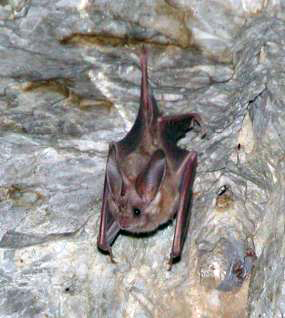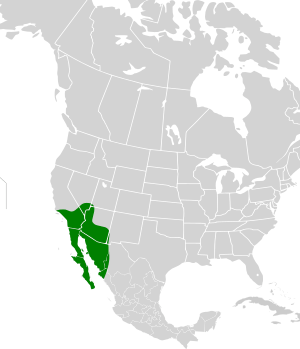California leaf-nosed bat facts for kids
Quick facts for kids California leaf-nosed bat |
|
|---|---|
 |
|
| Conservation status | |
| Scientific classification | |
| Genus: |
Macrotus
|
| Species: |
californicus
|
 |
|
The California leaf-nosed bat (scientific name: Macrotus californicus) is a fascinating type of bat. It belongs to a family called Phyllostomidae. You can find these bats living in the hot deserts of Mexico and the United States.
Discover the California Leaf-Nosed Bat!
Where Do They Live?
California leaf-nosed bats make their homes in the Sonoran Desert and Mojave Desert. They live in bushy areas near the Colorado River valley. This includes parts of southern California, Nevada, and Arizona. You can also find them across western Mexico. These bats do not travel far for winter. They also do not hibernate like some other bats.
What Do They Look Like?
The California leaf-nosed bat is a small, brown bat. It weighs about 12 to 20 grams. That's about as much as a few grapes! Its wings can spread over 30 centimeters wide. Its body is usually more than 6 centimeters long.
Amazing Ears and Noseleaf
This bat gets its name from a special feature. It has a triangular, fleshy growth of skin above its nose. This is called a "noseleaf." It helps the bat with its senses. These bats also have very large ears. Their ears are usually over 2.5 centimeters long. They are the only bats in their family in the U.S. with such big ears.
Inside a Bat's Body
Like other bats in the Macrotus group, this bat has many bones. It has twelve bones in its chest area (thoracic vertebrae). It also has six lower back bones (lumbar vertebrae). There are five bones in its hip area (sacral vertebrae). Finally, it has seven tail bones (caudal vertebrae).
Bat Babies: Reproduction and Life Cycle
These bats have an interesting way of having babies. They mate in the fall. After that, the baby bats (embryos) grow very slowly. This slow growth lasts until March. Then, they start growing faster. The baby bats are usually born in May or June. It is common for a mother bat to have twins!
How Humans Affect Bats
California leaf-nosed bats are sensitive to human activity. This is especially true in summer. During this time, mother bats are raising their young. Disturbing the caves where they sleep is a big problem.
These bats often sleep in old, abandoned mines. When people clean up or reopen these mines, it can harm bat populations. Since these bats do not hibernate or migrate, warm mine shafts are very important. They need these warm places to survive in colder areas.
Where Bats Sleep: Roosting Habits
During the day, California leaf-nosed bats sleep in special places. They choose caves, old mine tunnels, and deep rock shelters. They often stay close to the entrance, about 30 to 80 feet inside. They don't need completely dark spots. Sometimes, they even roost in tunnels that are less than 20 feet deep and quite bright.
A good bat home needs to be mostly enclosed. It also needs a roof to protect them from weather. The sleeping areas are usually large. This gives them plenty of ceiling space to hang from. It also gives them room to fly around inside. Cool temperatures are important too. Bats pick cool caves to escape the hot summer heat.
These bats like to hang from slanted parts of the ceiling. They use their feet to grip the rough rock easily. Often, a bat will rest while hanging by just one foot. The other foot is free to scratch or groom its fur. When they do this, their body might swing gently.
Amazing Flight Skills
The California leaf-nosed bat is an incredible flyer. It is known for being extremely agile. Sometimes, it flies quite fast. But usually, when it's looking for food, its flight is slow and floats gently. It's also quieter than most other bats. When flying straight, its wings make a soft fluttering sound.
Landing is a very interesting skill for these bats. They fly a bit below the ceiling. Then, they make a strong downward wing stroke. This pushes them upwards towards the ceiling. As they get close, they pull their wings back. At the same time, they flip their body upside down! Their back faces down, and their long legs reach for the ceiling. They grab on with their feet. Then, their wings give a final beat to steady them. These landings need perfect timing and judgment. They often land among other bats in a crowded space.
These bats have two main ways to start flying. They can drop from the ceiling and then swoop down before flying off. Or, they can take off directly from where they are hanging. They also often hover in the air. They can hover for several seconds, whether they are hunting or just moving around their sleeping spot.
Hunting for Food: Foraging Habits
The California leaf-nosed bat is an insectivore, meaning it eats insects. It's a "gleaning" hunter. This means it catches prey like crickets, grasshoppers, beetles, and sphinx moths directly from the ground or plants. It doesn't usually catch them in mid-air.
These bats use their excellent eyesight to find food. If it's completely dark, they switch to echolocation. This is like using sound waves to "see." They usually hunt just a few feet above the ground. They hover above an insect and snatch it up. Then, they take their meal to an open spot, like a porch, to eat it.
What's on the Menu?
California leaf-nosed bats mostly hunt close to the ground. They sometimes drop even closer and hover for a few seconds. Their diet shows how they hunt. They often eat insects that don't fly much, or even those that can't fly at all. This includes many types of orthopteran insects, moths, caterpillars, and beetles. This proves they pick insects off the ground or from plants.
Most leaf-nosed bats hunt for about an hour after sunset. Then, they go to a night roost. They have another busy hunting time in the early morning. This is usually a few hours before sunrise. Bats start returning to their daytime sleeping spots about two hours before sunrise. The last ones are usually back about twenty minutes before sunrise. A group of California leaf-nosed bats can eat a huge amount of insects. They can consume up to 250,000 pounds of insects in just one night!



